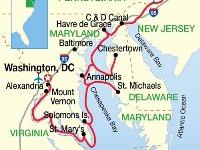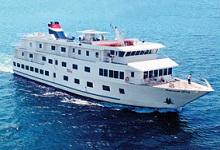Recently Viewed Cruises
- American Glory, Potomac & Tidewaters ex Philadelphia to Washington DCAdd to favourites
- Independence, Mid Atlantic Inland Passage ex Charleston to BaltimoreAdd to favourites
- American Glory, Potomac & Tidewaters ex Washington DC to PhiladelphiaAdd to favourites
- American Queen, Lower Mississippi Cruise ex Memphis to New OrleansAdd to favourites
- American Glory, Mid-Atlantic Inland Passage ex Charleston to BaltimoreAdd to favourites
- Luxury cruising booms
- Catch up on Cruising: Latest cruise news in bite size
- Royal Caribbean International raises the bar
- Classy Astor fills gap in market
- Oceanic Discoverer
- Frequently Asked Questions
-
American Glory, Potomac & Tidewaters ex Philadelphia to Washington DC
Nights 7 Ship American Glory Star Rating 
Departs Philadelphia, Pennsylvania Sailing 2013: 11 May ,25 May Ports of Call Philadelphia, Havre de Grace, Chestertown, St Michaels, Annapolis, St Mary's City, Mt Vernon, Washington DC Please enquire about this cruise for pricing.
7 Night Cruise sailing from Philadelphia to Washington DC aboard American Glory.
Discover the glorious cities and towns that helped to shape early American history, including some which have served as our nation's capitol. Your journey begins in Philadelphia, a city boasting centuries of political, economic, social, and cultural achievements and full of historical landmarks. Along the cruise, you'll visit places such as St. Michaels, MD known as the 'town that fooled the British,' America's sailing capital, Annapolis, MD, and Mt. Vernon, VA, the former plantation home of our first president, George Washington. With each port having its own unique history and culture, this cruise is sure to be the perfect way to explore the making of America as we know it today.
Day 1 Philadelphia
It was Philadelphia where Americans defended their liberty, achieved technological success, and forged the ideals of the American Dream. While visiting, you can enjoy the legacy from more than three centuries of political, economic, social, and cultural achievements. A commercial, educational, and cultural center, the city was once the second-largest in the British Empire (after London), and the social and geographical center of the original 13 American colonies. It was in this city that many of the ideas, and subsequent actions, gave birth to the American Revolution and American Independence, making Philadelphia a centerpiece of early American history.
Day 2 Havre de Grace
During the Revolutionary War, this small hamlet was visited several times by General Lafayette. He commented that the area reminded him of the French seaport of Le Havre, which had originally been named Le Havre-de-Grâce. Inspired by Lafayette's comments, the town was incorporated as Havre de Grace (Harbor of Grace) in 1785. Early industry in Havre de Grace included oyster and crab harvesting and fruit orchards. It was also the southern terminus for the Susquehanna and Tidewater Canal, which carried freight up the Susquehanna River to destinations inland. Havre de Grace was also known for duck hunting and a strong cottage industry of decoy making soon sprung up. Today Harve de Grace is the self proclaimed "Decoy Capital of the World."
Day 3 Chestertown
Founded in 1706, Chestertown is located on the banks of the Chester River. A visit to Chestertown offers a blend of history, arts, and shopping. Home to the Schooner Sultana, Chestertown provides a link to the maritime heritage of the Chester River and the Chesapeake Bay. Second to Annapolis in its number of 18th century homes, you will be presented with beautiful brick mansions and townhouses as you stroll along the waterfront. You will also find a delightful Farmers Market along Fountain Park as well as a dozen or more art galleries located throughout the city.
Day 4 St Michaels
Located on the eastern shore, St. Michaels is a popular destination with an eclectic mix of history, shops, restaurants, and small town charm. St. Michaels played a role in the War of 1812 when, in 1813, a fleet under the command of Admiral George Cockburn moved up the Chesapeake Bay, where the shipyards of Saint Michaels presented an inviting target. In the nighttime Battle of St. Michaels, the British bombarded the town, but failed to destroy the shipyards. As a result of the town's ruse of dimming the lights and hanging lanterns in the trees beyond the town, Saint Michaels became known as "the town that fooled the British". The Cannonball House, which was struck during this infamous battle, is on the National Register of Historic Places, as is the Saint Michaels Historic District. One of the town's chief attractions is the Chesapeake Bay Maritime Museum, located on land that was formerly part of the historic shipyards, and home to a number of historic bay vessels.
Day 5 Annapolis
Founded in 1649, Annapolis offers a delightful combination of history and a zest for living. Walk along the old brick sidewalks much as George Washington or Thomas Jefferson did in the days when Annapolis was the Capital of the United States. You will also find that Annapolis boasts some of the finest 17th and 18th Century buildings in the country, which includes the residences of all four Maryland signers of the Declaration of Independence. Annapolis is the home of the United States Naval Academy, founded in 1845, and also the home of St. John's College, founded in 1696 as King William's School and the third oldest institution of higher learning in the United States. Stroll along their famed waterfront or sit at City Dock and imagine what Annapolis might have been like during the 1700's, when the City was a bustling seaport with vessels sailing in to trade from all over the world. Or, watch sailboat races in the harbor and understand why Annapolis is America's Sailing Capital.
Day 6 St Marys
St. Mary's City was founded in 1634 by a group of English settlers. They arrived on the exploration ships Dove and Ark, which were led by Leonard Calvert, who was a part of the Barons Baltimore. St. Mary's City was the site of the fourth permanent settlement in British North America, Maryland's first capital, and the birthplace of religious toleration. It is an exciting mix of colorful living history and fascinating archaeology, all set in a beautiful tidewater landscape. During your stay in St. Mary's, you can enjoy several attractions such as exploring the Dove, Old Jail Museum, Calvert Marine Museum and the Patuxent River Naval Air Museum.
Day 7 Mt Vernon
Located near Alexandria, Virginia, Mt. Vernon was the plantation home of the first President of the United States, George Washington. The mansion is built of wood in a neoclassical Georgian architectural style, and the estate is located on the banks of the Potomac River. Mount Vernon was designated a National Historic Landmark in 1960 and is listed on the National Register of Historic Places. It is owned and maintained in trust by the Mount Vernon Ladies' Association. Visitors may tour the Mansion House and more than a dozen outbuildings including the slave quarters, kitchen, stables, and greenhouse. There are four gardens, a Forest Trail, and a George Washington: Pioneer Farmer site, a 4-acre working farm that includes a re-creation of Washington's 16-sided treading barn. George and Martha Washington are interred in a tomb where wreath laying ceremonies are held daily. The Slave Memorial and Burial Ground are nearby.
Day 8 Washington
Alexandria's many historic homes, churches, businesses and museums allow visitors to experience the hand of the past that makes it the charming and historic town it is today. The historic center of Alexandria is known as Old Town. With its concentration of high-end boutiques, fine restaurants, antique shops and theaters, it is a major draw for tourists and those seeking nightlife. Like Old Town, many Alexandria neighborhoods are compact, walkable, high-income suburbs of Washington D.C.







